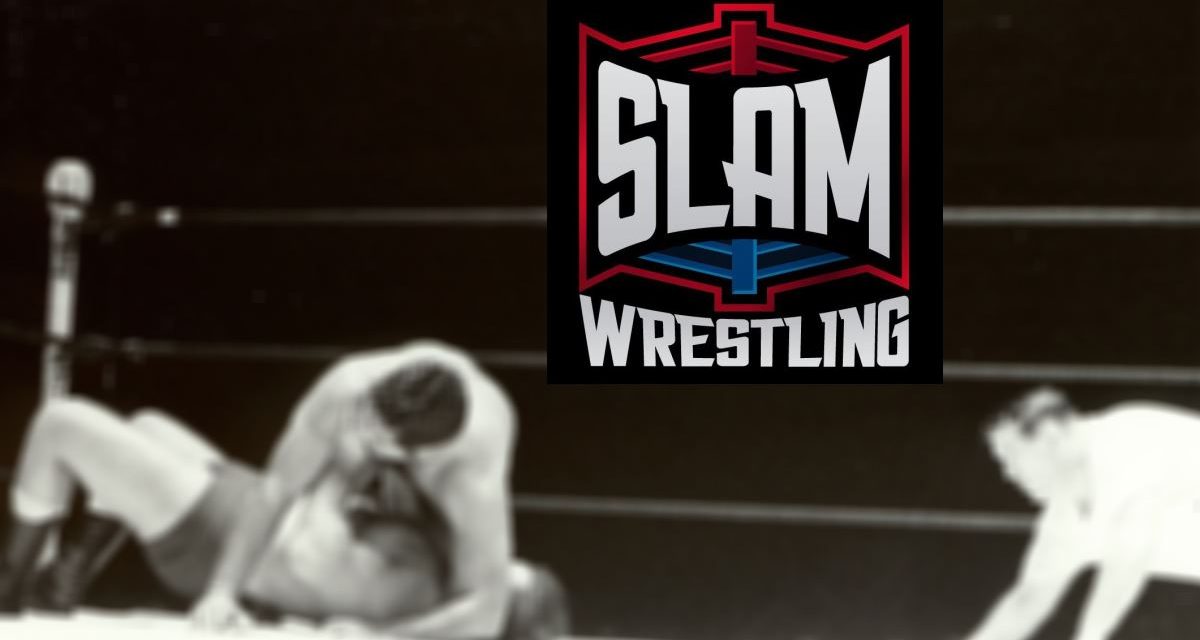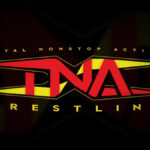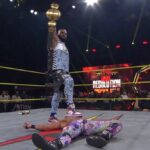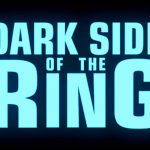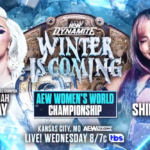“In the ring, those Osborne brothers were a little ponderous at times,” remembered Ross Hart, wrestler, promoter and member of Calgary’s famous Hart family. “Especially Bud, when he hit guys — they could feel it.”
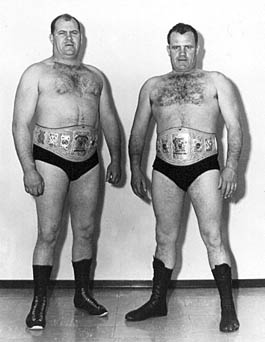
Bud (left) and Ray Osborne. Photos all by Bob Leonard.
The recent loss of William (Bud) Osborne can be felt across the prairies by those who remember Edmonton’s notorious brother tag team of Bud and Ray Osborne, who wreaked havoc throughout Stampede Wrestling from the 1950s through to the ’70s. Bud Osborne died on June 21 from heart failure at the age of 80.
Ray Osborne, older brother to Bud and tag team partner for 25 years, recently told the Edmonton Journal, “You have got to wrestle to your personality, and (Bud) was a natural born heel. He could get people so riled up they wanted to kill him.”
Florence Loyie of the Edmonton Journal wrote: “Bud was a fierce competitor right from the start of his wrestling career, losing six teeth in one match and patches of hair in others.” In the article, Loyie said Bud once told a newspaper reporter, “Everyone wants to progress in the eyes of the promoter. It’s like if I figure I can better myself by bashing a guy and busting him open, I will do it.”
And progress they did, as Bud and Ray Osborne won the North American tag team titles on three occasions, bashing opponents and busting heads along the way. Philip Klein, a fellow native of Rocky Mountain House, AB, remembered the trail of blood the Osbornes left across the province of Alberta: “I caught an elbow smash (from Ray Osborne) and it broke my nose,” Klein said in the book Heath McCoy’s book Pain and Passion: The History of Stampede Wrestling. “I rolled out of the ring (covered in blood) and one of the fans said, ‘Ah, it’s just ketchup.’ I took a handful of blood, wiped it across his face, and said, ‘Try that on fer ketchup!'”
Hart agreed the Osborne brothers were not the most graceful wrestlers of that era: “They certainly weren’t the easiest tag team to wrestle, and there were a lot of guys who didn’t like working against them,” Hart told SLAM! Wrestling from Calgary, AB. “They were fairly stiff and solid, but they were real life brothers — close knit brothers — and they had some of their best and most memorable matches against Bobby and Jerry Christy, who were one of the top babyface tag teams at that time.”
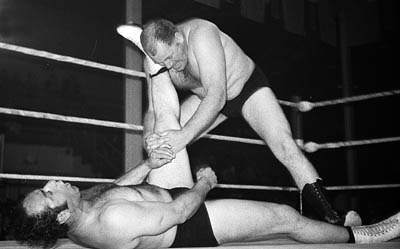
Bud has Marcel Trudeau stretched out like a carpet, pinning one leg to the mat while putting a severe stretch on the other limb.
Bobby and Jerry Christy concurred: “With Bud and Ray, we had some great matches that were usually two-out-of-three falls, and we’d go half an hour to 40 minutes — and boy, could they irritate the fans,” Bobby Christy told SLAM! Wrestling from his home in Los Angeles, CA.
Jerry Christy chimed in, “But you really had to watch yourself in the ring with those two. They were a little dangerous to say the least. They were very rugged, more so than most wrestlers I would say — and those guys, they looked rugged too.”
The Christy brothers agreed that Bud, especially, was a big, balding brute when compared to his brother Ray.
“I was big and ugly,” said Bud Osborne in the book Pain and Passion. “My brother was shorter, with dark curly hair. He’d come out and people would whoop and cheer. Then I’d come out right behind him and, Christ, they were threatening to kill me before I done anything. Ray was a much better worker than me, so I raised all the ruckus and he settled it down.”
The Christy brothers credited both Bud and Ray as being professional, both in and out of the ring: “Like my brother and I, they were a team who worked to make it a good match every night,” said Jerry. “A lot of wrestlers who were in tag teams during that period weren’t working for the match or even the tag team, but for themselves — trying to make themselves look good. But like us, Bud and Ray weren’t selfish that way, and the hard work they put in was so the match would look good.”
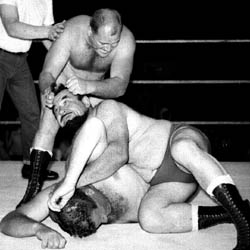
Dave Ruhl clamps his full nelson finisher on Ray, but Bud breaks it up with a fistful of hair.
Bobby concurred, “Outside the ring, in the locker room they were quiet, not boisterous by any means. They were good guys and fit in well with the atmosphere of Stampede Wrestling, the way Stu conducted business and upheld the dignity of wrestling.”
Long-time wrestling promoter and photographer Bob Leonard remembered the Osbornes well: “Like a lot of people in Stampede Wrestling, they had their rough edges but Bud and Ray were great people,” said Leonard from his home in Regina, SK. “They were genuinely rough and tough guys, but they weren’t overboard villains. I recall that Bud was a little more direct and gruff than Ray, while Ray tended to be a little quieter. But in that ring, they were a couple of big, hefty guys who worked pretty rough, and I remember their style never changed all that much. And I can remember there was a lot of blood in some of their matches.”
In Pain and Passion, McCoy wrote: “Some of the earliest blood baths in the Stampede territory came as a result of Bud’s fierceness. (The Osbornes) spread the blood across their faces and through their hair until it looked like their skulls had been cracked. Pandemonium ensued.
“In a 1954 match in Calgary, Bud’s opponent broke his nose and stuck a thumb in his right eye, permanently impairing his vision by 20 percent. Bud retaliated by chomping off the end of his opponent’s nose. ‘I can still feel my teeth going through,’ he told the Edmonton Journal in 1978.
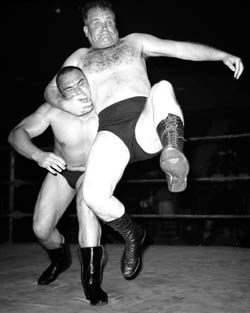
Ray uses the Osborne bulldog to bring Archie “The Stomper” Gouldie to the mat.
“Based in Alberta, Ray and Bud wrestled until 1979, when they finally said to hell with it and retired to concentrate on their thriving real estate business. Bud says the toughest man he ever faced was Stu Hart. ‘In the ring, he was the best. Mean as hell. None was meaner. He respected you if you had talent and fought back, but if he hated you and you had no visible skills, he’d tear you apart. On the mat, I was not his equal. Very few men were.’ Bud is quick to add that Stu never hurt him. ‘He knew good and well if he did any of that stuff, I’d take a club to him. Or a gun.'”
Hart recalled reading that chapter in Pain and Passion, and added: “Interestingly, Bud and Ray were going to buy my dad’s promotion in 1978 when they made Stu an offer to buy the rights to the promotion,” said Hart. “They made a down payment on the property to Stu, but I think they made some poor real estate deals and they couldn’t come up with the balance of the payment and they had to forfeit. Looking back now, it was probably a blessing for Stampede Wrestling because after that, Stu brought in Dynamite Kid and a number of other big stars and the territory caught on fire. It would have been completely different had Bud and Ray bought the promotion out, because they really didn’t know a lot about promoting and didn’t have the background.”
Loyie of the Edmonton Journal wrote: “In addition to wrestling for promoters, the (Osborne) brothers fronted their own shows. At one time, they had a stable of acts that included six (midget) wrestlers, 12 female wrestlers, and a 500-pound black bear named Terrible Ted.”
Jerry Christy remembered, “They were living in Edmonton, and they promoted some small shows that we wrestled for. In fact, the last time we ever wrestled them was in 1971 at the Pavilion in Calgary, and I think they were the promoters.”
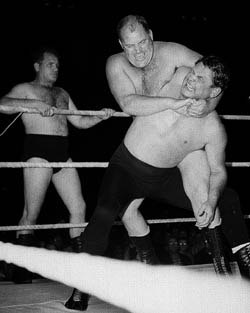
Jack Pesek is trapped in Bud’s abdominal stretch, as Ray stands ready to take over.
Loyie’s article continued: “Bud, who was also known as ‘Bulldog’ to wrestling fans, had a great skill for recognizing talents in other people who were over the hill and washed up, Ray said. ‘He could take them and get miles of work out of them. He always surrounded himself with people who he thought had a lot to offer to society.'”
Though Ray Osborne retired from wrestling in 1978, Bud Osborne carried on for another year wrestling in singles matches. “Bud could hold his own in singles matches as well,” said Hart. “Bud had some great matches with Sweet Daddy Siki, Archie ‘The Stomper’ Gouldie, and Pat O’Connor — very memorable.
“But I think they were best as a duo, and Bud was definitely the leader,” Hart added. “They were great heels who the fans loved to hate, and together they definitely made for an interesting tag team.”
In Pain and Passion, Bud Osborne agreed: “We made a hell of a team.”
